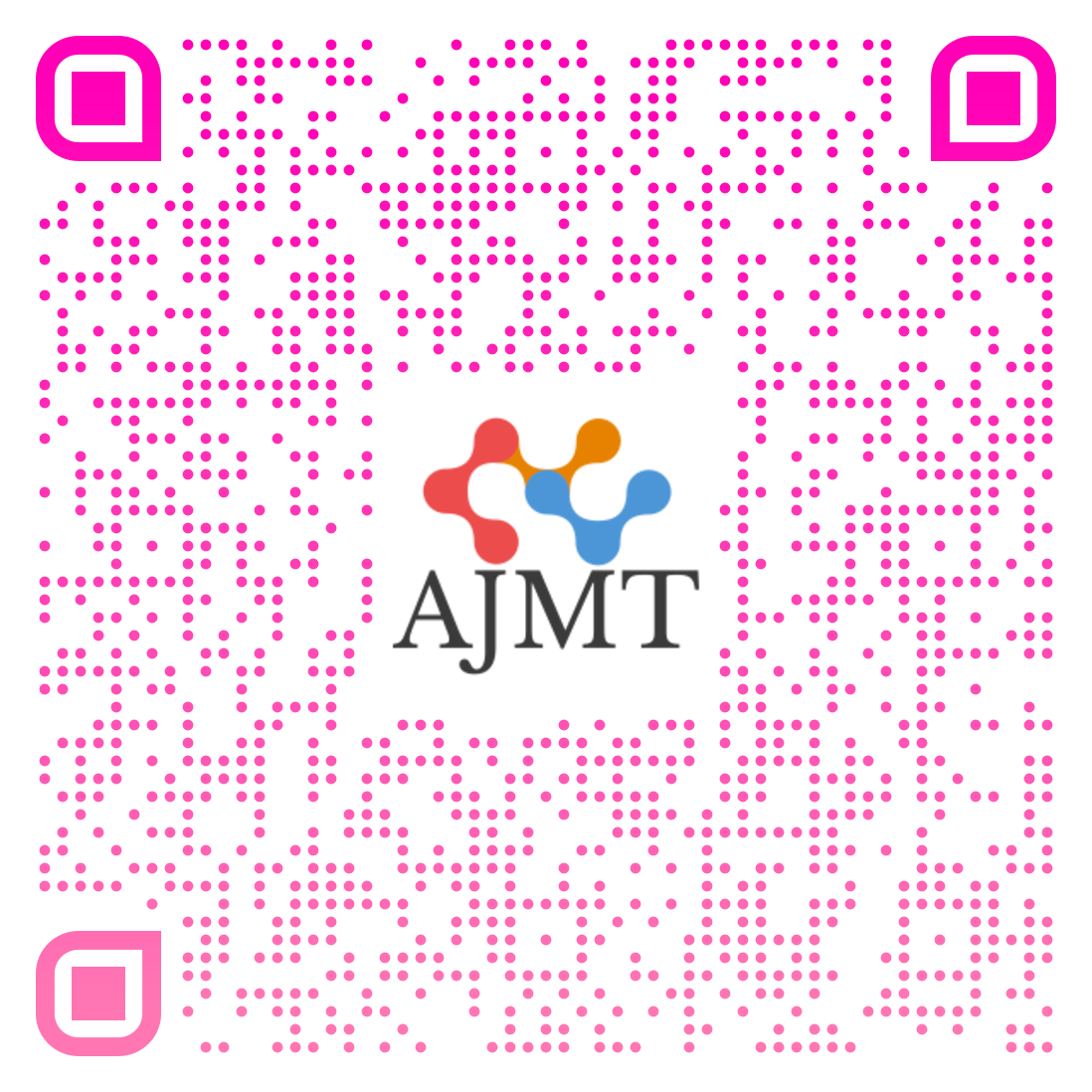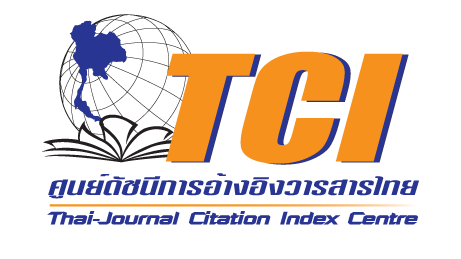การศึกษาคำปรากฏร่วมของคำศัพท์ทางวิชาการแบบอิงตามคลังข้อมูลในบทความในวารสาร
DOI:
https://doi.org/10.14456/ajmt.2025.7คำสำคัญ:
คำนาม, คำปรากฏร่วม , คำปรากฏร่วมทางวิชาการ , คลังข้อมูลภาษา, บทความวิชาการบทคัดย่อ
การจัดวางคำร่วมกันเป็นเรื่องยากโดยเฉพาะสำหรับผู้เรียนภาษาอังกฤษเนื่องจากภาษาแม่มีอิทธิพลต่อผู้เรียน การศึกษานี้ใช้รูปแบบคลังข้อมูลในการวิเคราะห์คำนามที่ปรากฏในบทความในวารสาร บทความนี้จะสำรวจความถี่รูปแบบของการจัดวางคำนามร่วมกัน 10 อันดับแรกซึ่งนำมาจากวารสารสามอันดับแรกตามการจัดอันดับวารสาร SCImago (SJR) ระหว่างปีพ.ศ. 2563 ถึง 2564 ข้อมูลจากบทความในวารสารวิชาการ 60 บทความรวบรวมจากการเว็บไซต์ ResearchGate และวิเคราะห์โดยโปรแกรม Antconc เพื่อตรวจสอบความถี่ของคำนาม และ TagAnt เพื่อจำแนกประเภทของคำ การวิเคราะห์รูปแบบการจัดวางได้ชี้ให้เห็นการจัดวางคำนามร่วมกันหลายชุด ซึ่งรวมถึงการจัดวางที่ค่อนข้างจำกัด เช่น ‘foreign + language’, ‘learning + English’ และ ‘participants + in’ และการจัดวางที่ค่อนข้างอิสระ เช่น ‘allow + students’, ‘presenting + learners’, ‘analyze + data’ ผลการวิจัยเหล่านี้ให้คำแนะนำสำหรับผู้เรียนภาษาอังกฤษที่ต้องการปรับปรุงกลยุทธ์การเรียนรู้คำศัพท์ของตน
เอกสารอ้างอิง
Ahmad, A., & Riaz, M. (2024). A study of analyzing the impact of L2 on learning the collocations of English among university students in Punjab, Pakistan. Journal of Regional Studies Review, 3(1), 51-58. https://doi.org/10.62843/jrsr/2024.3a025
Alotaibi, A. (2014). The comprehension of English Lexical Collocates by Kuwahiti EFL Learners. International Journal of English Language and Linguistics Research, 2(3), 1-12. https://www.eajournals.org/wp-content/uploads/The-comprehension-of-English-lexical-collocations-by-Kuwaiti-EFL-learners.pdf
Ang, L. H., Tan, K. H., & He, M. (2017). A corpus-based collocational analysis of noun premodification types in academic writing. 3L The Southeast Asian Journal of English Language Studies, 23(1), 115-135. https://doi.org/10.17576/3L-2017-2301-09
Anthony, L. (2005). AntConc: Design and development of a freeware corpus analysis toolkit for the technical writing classroom. In 2005 IEEE International Professional Communication Conference (IPCC) (pp. 729-737). IEEE Eplore. https://doi.org/10.1109/IPCC.2005.1494244
Anthony, L. (2022). TagAnt (Version 2.0.5) [Computer Software]. Tokyo, Japan, Waseda University. Retrieved from https://www.laurenceanthony.net/software
Baker, P. (2010). Sociolinguistics and corpus linguistics. Edinburgh University Press. http://site.ebrary.com/id/10391765
Bazzaz, F. E. (2013). Verb-Noun Collocation Proficiency and Academic Years. International Journal of Applied Linguistics & English Literature, 3(1), 152-162. https://doi.org/10.7575/aiac.ijalel.v.3n.1p.152
Bazzaz, F. E., & Samad, A. (2011). The use of Verb noun collocations in writing stories among Iranian EFL Learners. English Language Teaching, 4(3). https://doi.org/10.5539/elt.v4n3p158
Bennett, G. R. (2010). Using corpora in the language learning classroom: corpus linguistics for teachers. The University of Michigan Press. https://doi.org/10.3998/mpub.371534
Biber, D., Conrad, S., & Reppen, R. (1998). Corpus linguistics : investigating language structure and use. Cambridge University Press.
Boonphoie, P., & Bhoomkhokrak, P. (2024). Integrating CLIL and Project-Based Learning to enhance sixth graders’ English reading achievement. Academic Journal of Management Technology, 5(1), 16-28. https://doi.org/10.14456/ajmt.2024.2
Boonraksa, T., & Naisena, S. (2021). A Study on English Collocation Errors of Thai EFL Students. English Language Teaching, 15(1), 164-177. https://doi.org/10.5539/elt.v15n1p164
Brett, D., Loranc-Paszylk, B., & Pinna, A. (2021). A corpus-driven analysis of adjective/noun collocations in travel journalism in English, Italian and Polish. MonTI. Monografías de Traducción e Interpretación, (13), 114-147. https://doi.org/10.6035/MonTI.2021.13.04
Bueraheng, N., & Laohawiriyanon, C. (2014). Does learners' degree of exposure to English language influence their collocational knowledge? introduction. International Journal of English and Literature (IJEL), 4(3), 1-10.
Chen, Q., & Ge, G. (2007). A corpus-based lexical study on frequency and distribution of Coxhead’s AWL word families in medical research articles (RAs). English for Specific Purposes, 26(4), 502-514. https://doi.org/10.1016/j.esp.2007.04.003
Cowie, A. P. (1998). Phraseology: theory, analysis, and applications. Oxford Academic. https://books.google.co.th/books?id=Df-iQpNMLcgC
Coxhead, A. (2000). A new academic word list. TESOL Quarterly, 34(2), 213-238.
Crystal, D. (2003). English as a global language (2nd ed.). Cambridge University Press. https://doi.org/10.1017/CBO9780511486999
Dash, N. S. (2008). Corpus linguistics: an introduction. Pearson Longman. https://books.google.co.th/books?id=ikOZWjkkxzEC
Dukali, A. A. (2018). An error analysis of the use of lexical collocations in the academic writing of libyan EFL University students. Journal of Second Language Teaching and Research, 6(2), 55-91.
Ghaniabadi, S., Marjane, E., & Zareian, G. (2015). The use of adjective+noun collocations by Iranian EFL learners based on noun abstractness. International Journal of Linguistics, 7(5), 86. https://doi.org/10.5296/ijl.v7i5.8143
Harta, I., Bay, I. W., & Ali, S. (2021). An analysis of lexical collocation errors in students’ writing. TRANS-KATA: Journal of Language, Literature, Culture and Education, 2(1), 15-25. https://doi.org/10.54923/transkata.v2i1.18
Hill, J. (2000). Revising priorities: from grammatical failure to collocational success. In M. Lewis (Ed.), Teaching collocation: Further developments in the lexical approach (pp. 47-67). Oxford University Press.
Holtz, M. (2007). A corpus-based analysis of verb/noun collocations in interdisciplinary registers. In Davies. M, Rayson. P, Hunston. S, & Danielsson. P. (Eds.), Corpus Linguistics Conference 2007 (pp.1-12). UCREL. http://ucrel.lancs.ac.uk/publications/CL2007/paper/14_paper.pdf
Howarth, P. A. (1996). Phraseology in English academic writing: some implications for language learning and dictionary making. Walter de Gruyter GmbH. https://books.google.co.th/books?id=uFq6AAAAIAAJ
Howarth, P. A. (1998). Phraseology and second language proficiency. Applied Linguistics, 19(1), 24-44. https://doi.org/10.1093/applin/19.1.24
Khani, R., & Tazik, K. (2013). Towards the development of an academic word list for applied linguistics research articles. RELC Journal, 44(2), 209-232. https://doi.org/10.1177/0033688213488432
Kirub, A. (2014). Essentials of scientific writing. Addis Ababa: Ethiopian Institute of Agricultural Research (EIAR).
Lewis, M. (2000). Teaching collocation : further developments in the lexical approach. Language Teaching Publications.
Martínez, I. A., Beck, S. C., & Panza, C. B. (2009). Academic vocabulary in agriculture research articles: A corpus-based study. English for Specific Purposes, 28(3), 183–198. https://doi.org/10.1016/j.esp.2009.04.003
McCarthy, M., O’Dell, F., & Walsh, S. (2010). English collocations in use: advanced. Cambridge University.
McCarthy, M., O’Dell, F., & Walsh, S. (2017). English Collocations in Use. Intermediate (2nd ed.). Klett Sprachen GmbH.
McEnery, T., & Wilson, A. (2001). Corpus linguistics : an introduction (2nd ed.). Edinburgh University Press.
Meara, P. (1992). EFL vocabulary tests. Centre for Applied Language Studies, University of Wales, Swansea.
Mongkolchai, A. (2008). A study of University students’ ability in using English collocations. [Master’ s thesis, Srinakharinwirot University]. Integrated Thesis & Research Management System. http://thesis.swu.ac.th/swuthesis/Eng(M.A.)/Angkana_M.pdf
Mozaffari, A., & Moini, R. (2014). Academic words in education research articles: a corpus study. Procedia - Social and Behavioral Sciences, 98, 1290-1296. https://doi.org/https://doi.org/10.1016/j.sbspro.2014. 03.545
Nampanya, R., & Wangmo, N. (2020). The awareness of phrasal verb collocations of third year (EIC) major students at Rajamangala University of Technology Isan, Surin Campus. Academic Journal of Management Technology, 1(1), 120-128. https://so03.tci-thaijo.org/index.php/jomt/article/view/246613
Nilsson, F. (2019). A comparative analysis of word use in popular science and research articles in the natural sciences : A corpus linguistic investigation [Bachelor's thesis, MäLardalen University]. MäLardalen University Library. http://mdh.diva-portal.org/smash/get/diva2:1330702/FULLTEXT01.pdf
Ordem, E., & Bada, E. (2016). Lexical collocations (verb + noun) across written academic genres in English. European Journal of Education Studies, 1(3), 20-37. https://doi.org/10.5281/zenodo.51567
Peacock, M. (2012). High-frequency collocations of nouns in research articles across eight disciplines. Iberica, 23(5), 29-46.
Phiwma, N. (2023). Effects of blended Game-based Learning in enhancing learning achievements in vocabulary, grammar, and idioms for formal presentations in “English for Presentations” course of computer science students at Suan Dusit University. Academic Journal of Management Technology, 4(2), 84-96. https://doi.org/10.14456/ajmt.2023.6
Putra, D., & Suhardijanto, T. (2019). The use of verb + noun collocations by English learners of Indonesian. In Proceeding of the 4th International Seminar on Linguistics (ISOL-4) (pp. 25–33). De Gruyter. https://www.researchgate.net/publication/338278740_The_Use_of_Verb_Noun_Collocations_by_English_Learners_of_Indonesian
Ridha, N. A., & Riyahi, A. A. (2011). Lexical collocational errors in the writings of Iraqi EFL learners. Journal of the College of Arts, 58, 24-51.
Sanguannam, S. (2017). A study on “Delexical Verb+Noun” collocation errors of Thai EFL intermediate and advanced learners. A Journal of Liberal Arts, 17(2), 59-84.
Schmitt, N. (2000). Vocabulary in language teaching (12th ed.). Cambridge University Press. https://books.google.co.th/books?id=0HNly9nxBXgC
SCImago. (n.d.). SJR — SCImago Journal & Country Rank. http://www.scimagojr.com
Shabani, M. B., & Tazik, K. (2014). Coxhead’s AWL across ESP and Asian EFL Journal Research Articles (RAs): a corpus-based lexical study. Procedia - Social and Behavioral Sciences, 98, 1722-1728. https://doi.org/https://doi.org/10.1016/j.sbspro.2014.03.599
Szudarski, P. (2018). Corpus linguistics for vocabulary: a guide for research. Routledge. https://books.google.co.th/books?id=B2dBswEACAAJ
Takač, V.P. & Lukač. M. (2013). How word choice matters: An analysis of adjective-noun collocations in a corpus of learner essays. Jezikoslovlje, 14(2-3), 385-402.
Trinant, K., & Yodkamlue, B. (2019). Lexical Collocations in a Sample Corpus of Nursing Research Articles (SCNRA). Suranaree journal of social science, 13(1), 45-72.
Tungyai, S., & Rakpa, S. (2021). Collocation Competence : A Case Study of Undergraduate Students. Journal of MCU Humanities Review, 7(1), 331–346. https://so03.tci-thaijo.org/index.php/human/article/view/252738
Uçar, S., & Yükselir, C. (2015). The effect of corpus-based activities on verb-noun collocations in EFL classes. Turkish Online Journal of Educational Technology, 14(2), 195-205.
Viera, R. T. (2016). The importance of vocabulary knowledge in the production of written texts: a case study on EFL language learners. Revista Tecnológica ESPOL – RTE, 30(3), 89-105.
Vongpumivitch, V., Huang, J., & Chang, Y. (2009). Frequency analysis of the words in the Academic Word List (AWL) and non-AWL content words in applied linguistics research papers. English for Specific Purposes, 28(1), 33-41. https://doi.org/https://doi.org/10.1016/j.esp.2008.08.003
West, M. (1953). A general service list of English words: with semantic frequencies and a supplementary word-list for the writing of popular science and technology. Longman. https://books.google.co.th/books?id=WcYMAQAAIAAJ
Yakhontova, T. V. (2003). English academic writing for students and researchers (2nd ed.). Lviv: PAIS.
Yumanee, C., & Phoocharoensil, S. (2013). Analysis of collocational errors of Thai EFL students. LEARN Journal: Language Education and Acquisition Research Network, 6(1), 88–98. https://so04.tcithaijo.org/index.php/LEARN/article/view/10272
ดาวน์โหลด
เผยแพร่แล้ว
รูปแบบการอ้างอิง
ฉบับ
ประเภทบทความ
สัญญาอนุญาต
ลิขสิทธิ์ (c) 2025 คณะเทคโนโลยีการจัดการ มหาวิทยาลัยเทคโนโลยีราชมงคลอีสาน วิทยาเขตสุรินทร์

อนุญาตภายใต้เงื่อนไข Creative Commons Attribution-NonCommercial-NoDerivatives 4.0 International License.
บทความที่ได้รับการตีพิมพ์เป็นลิขสิทธิ์ของคณะเทคโนโลยีการจัดการ มหาวิทยาลัยเทคโนโลยีราชมงคลอีสาน วิทยาเขตสุรินทร์
ข้อความที่ปรากฏในบทความแต่ละเรื่องในวารสารวิชาการเล่มนี้ เป็นความคิดเห็นส่วนตัวของผู้เขียนแต่ละท่านไม่เกี่ยวข้องกับคณะเทคโนโลยีการจัดการ มหาวิทยาลัยเทคโนโลยีราชมงคลอีสาน วิทยาเขตสุรินทร์ และคณาจารย์ท่านอื่นๆในมหาวิทยาลัยฯ แต่อย่างใด ความรับผิดชอบองค์ประกอบทั้งหมดของบทความแต่ละเรื่องเป็นของผู้เขียนแต่ละท่าน หากมีความผิดพลาดใดๆ ผู้เขียนแต่ละท่านจะรับผิดชอบบทความของตนเองแต่ผู้เดียว










